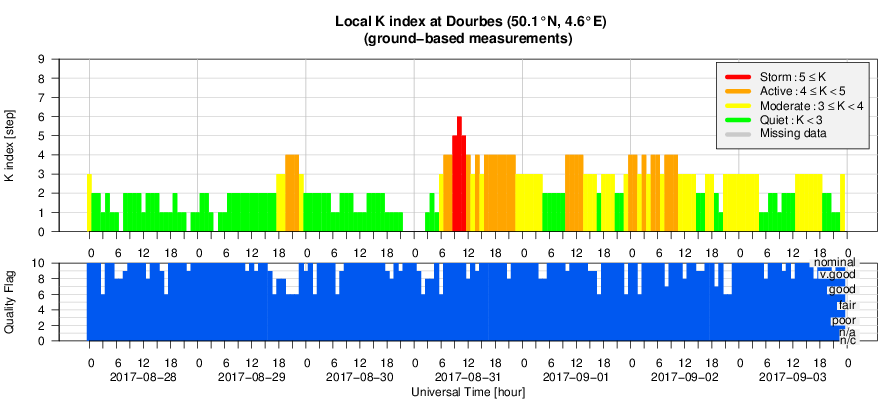- Table of Content
- 1.Weather in spa...
- 2.The Sun keeps ...
- 3.PROBA2 Observa...
- 4.Review of sola...
- 5.The Internatio...
- 6.Review of geom...
- 7.Geomagnetic Ob...
- 8.The SIDC Space...
- 9.Review of iono...
- 10.Future Events
2. The Sun keeps on throwing parties
3. PROBA2 Observations (28 Aug 2017 - 3 Sep 2017)
4. Review of solar activity
5. The International Sunspot Number
6. Review of geomagnetic activity
7. Geomagnetic Observations at Dourbes (28 Aug 2017 - 3 Sep 2017)
8. The SIDC Space Weather Briefing
9. Review of ionospheric activity (28 Aug 2017 - 3 Sep 2017)
10. Future Events
Weather in space is picking up
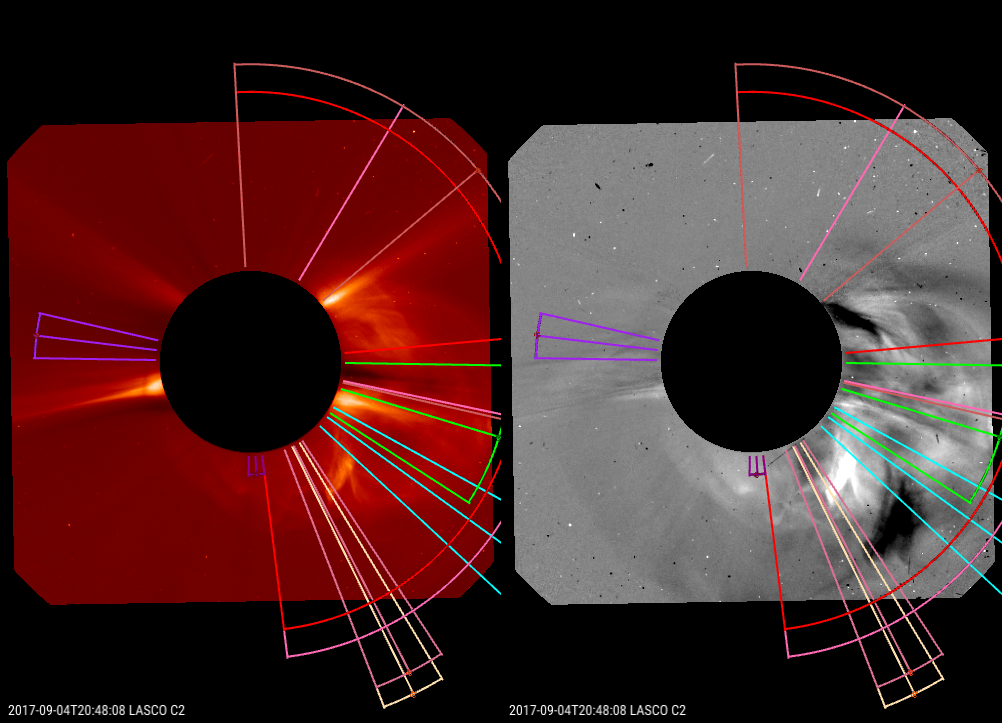
movie: http://www.stce.be/movies/JHV_2017-09-05_08.30.19.mp4
This very cool movie (click on the picture to watch the movie) shows the space environment in the Sun’s neighbourhood. The coronagraph LASCO onboard the spacecraft SOHO recorded it. The black disk occults the Sun such that the direct overwhelming light is blocked, it is simply an artificial solar eclipse. The white moving features are plasma clouds ejected from the Sun: Coronal Mass Ejections or CMEs. The coloured arcs indicate how wide and how fast those CMEs are. The left movie is made in visible light (the red is artificial - space doesn’t look red), the right movie is a difference movie in which two images are subtracted such that you see the difference between the two images. In this way, plasma clouds that look faint in the red movie are better seen.
On September 2, a cloud moving to the right is visible. A shock in front of the cloud (similar like what happens with a speed boat) accelerated electrons such that they started to emit radio waves. These waves were recorded by our radio instruments in Humain, Belgium and are seen as a bright blob in the Frequency-Time graph (below). When we see a blob like this, we immediately check the solar environment for clouds.
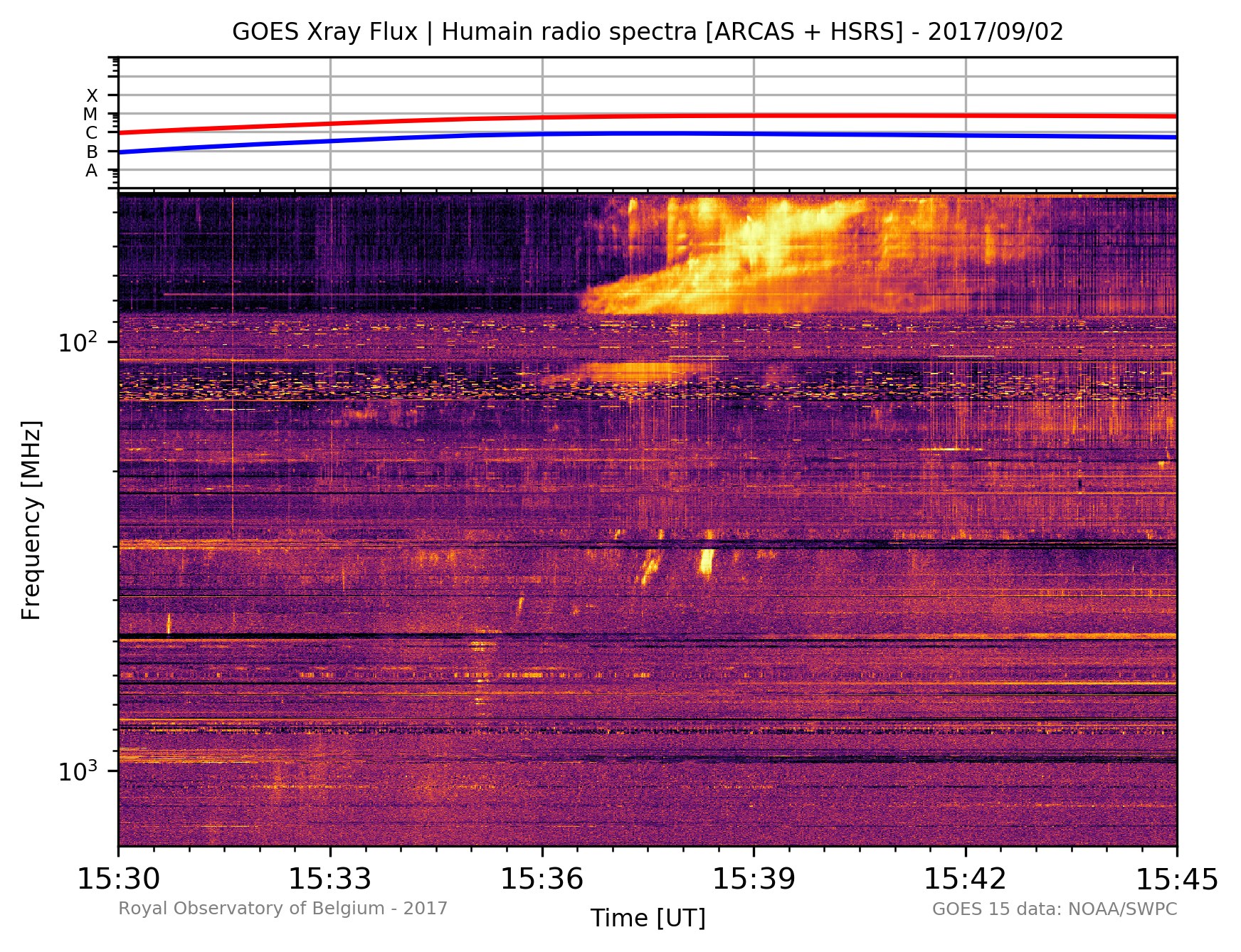
The Sun continued on this rhythm. On September 4, a really fat cloud was seen in the red and grey movie. At a certain point, the cloud even seems to enfold the entire black disk. This is what we call a halo CME. It is a cloud that moves along the Sun-Earth line. And this one was heading into the direction of the Earth. It bumped on the Earth’s magnetic field on September 6 around 23:00UT. The local K Dourbes and NOAA Kp reached the level '4' on a scale ranging from 0 to 9.
Check the alerts of our Space Weather forecast centre: http://sidc.be
The Sun keeps on throwing parties
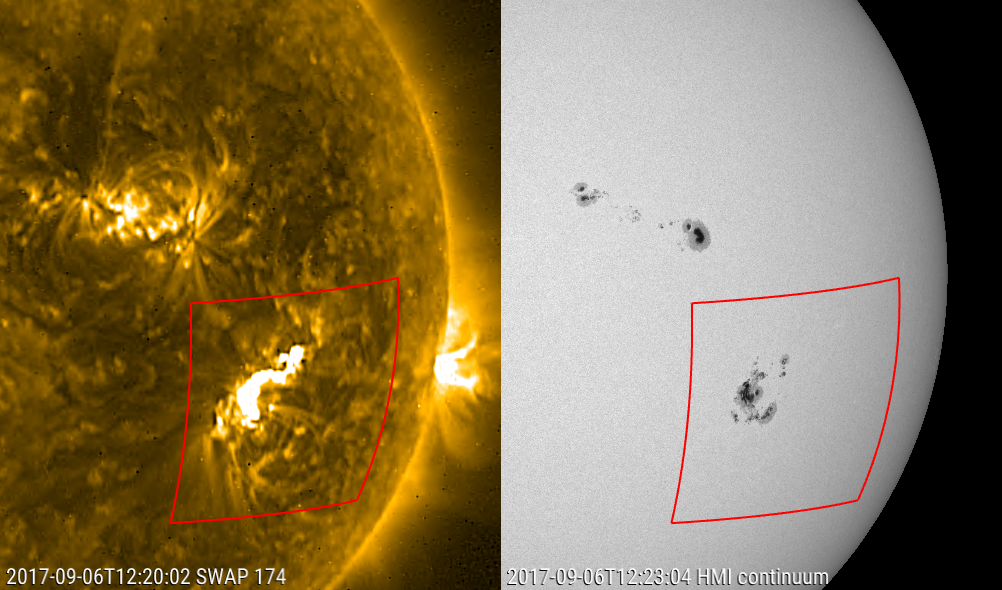
This is how the trouble maker looks: the complicated sunspot on the solar surface (grey image) holds magnetic tubes that reach high into the solar atmosphere (yellow image). The solar structure became unstable releasing a light flash around Sept 6, 12:00UT. It is a flash over the entire spectrum: radio waves, visible light, extreme UV, x-rays, gamma. It takes light only 8 minutes to bridge the distance Sun-Earth. The last flash of a similar strength happened on 2006, Dec 5. The most recent flare stronger than that of yesterday occurred on 2005, Sept 7 - exactly 12 years ago and was almost twice as strong.
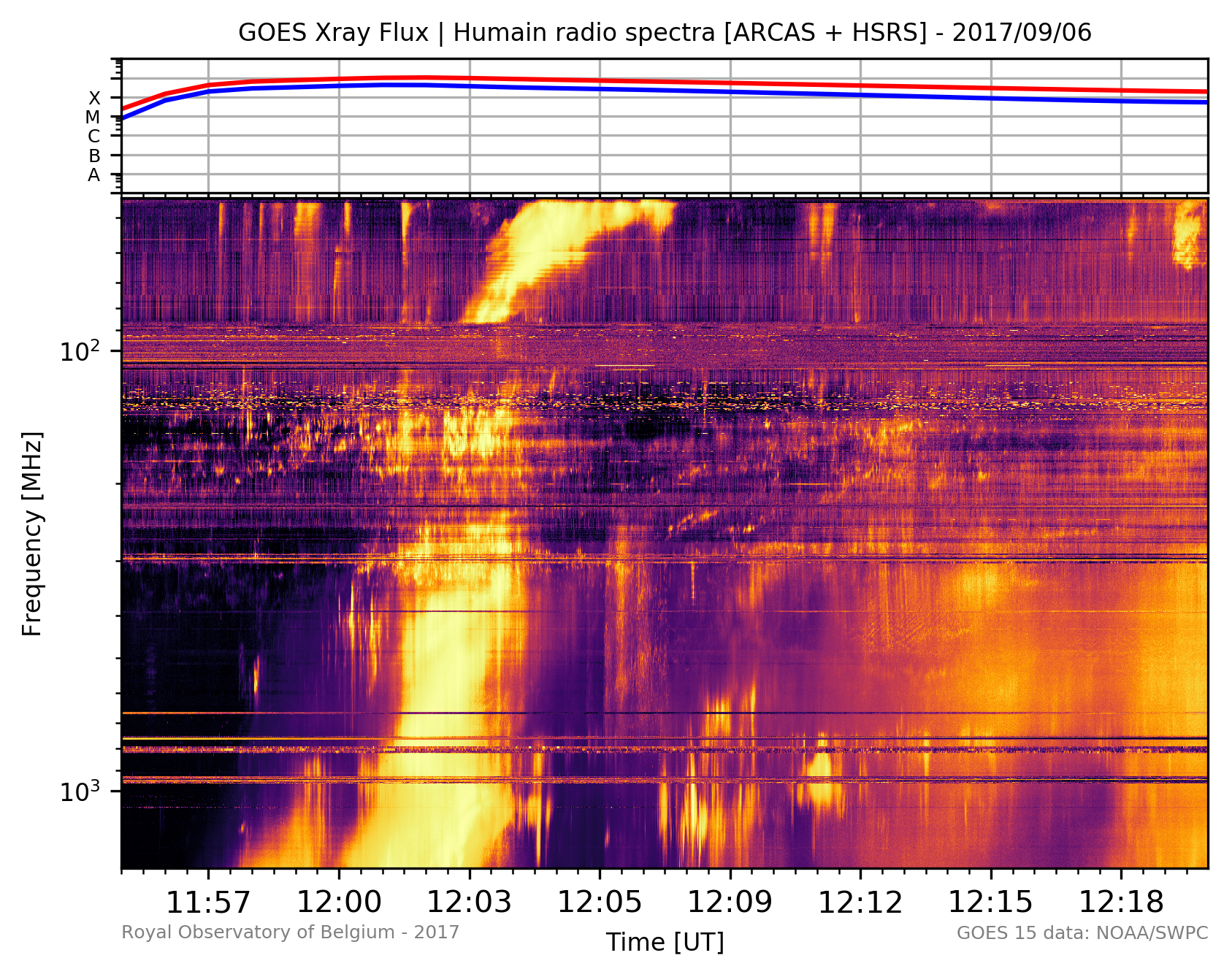
Our antennas in Humain captured the radio part of the flash. It is seen as a bright structure in a Frequency - Time graph. A bright area in the graph means that the flash was very intense in that particular frequency at that particular time. If you have some imagination, you could recognize Godzilla in it.
At the same time, the GNSS navigation research group was also alerted by their Solar Radio Burst warning system. They saw 'scintillations', i.e. fluctuations in GNSS signals above Europe. GNSS signals pass through the Earth's atmosphere that is impacted by the light flash. These scintillations might disturb the navigation system.
The team in charge of the operations of the PROBA2 satellite were even more excited. At the moment of the light flash, the EUV spectograph LYRA was running a special observation campaign with one of its spare units. This exceptional observation could maybe shed a light on the mechanisms that triggers a flash in the LYRA frequency.
Together with the light flash, the sun also expelled a plasma cloud. The Space Weather service center of the STCE estimated the arrival second half of Sept 8. The picture below shows the cloud: it is the white structure. You see it is much bigger than the Sun, the yellow ball in the middle. Clouds are indeed HUGE.
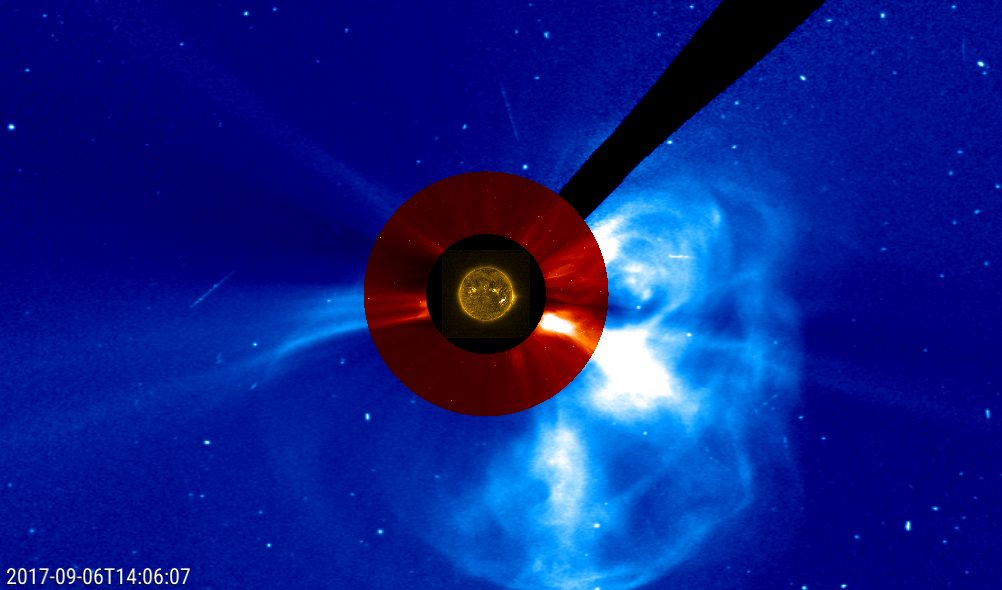
More radio news: http://sidc.be/humain/event_x9_20170906.php
More GNSS news: http://www.gnss.be/Atmospheric_Maps/srb_event.php?date=2017-09-06
The Solar Radio Burst Alert page: http://www.gnss.be/Atmospheric_Maps/SRB_warning.php
More LYRA hot news: http://proba2.oma.be/HerzbergFlare
PROBA2 Observations (28 Aug 2017 - 3 Sep 2017)
Solar Activity
Solar flare activity fluctuated between very low and low during the week.
In order to view the activity of this week in more detail, we suggest to go to the following website from which all the daily (normal and difference) movies can be accessed: http://proba2.oma.be/ssa
This page also lists the recorded flaring events.
A weekly overview movie can be found here (SWAP week 388): http://proba2.oma.be/swap/data/mpg/movies/weekly_movies/weekly_movie_2017_08_28.mp4
Details about some of this week's events, can be found further below.
If any of the linked movies are unavailable they can be found in the P2SC movie repository here: http://proba2.oma.be/swap/data/mpg/movies/
Wednesday Aug 30
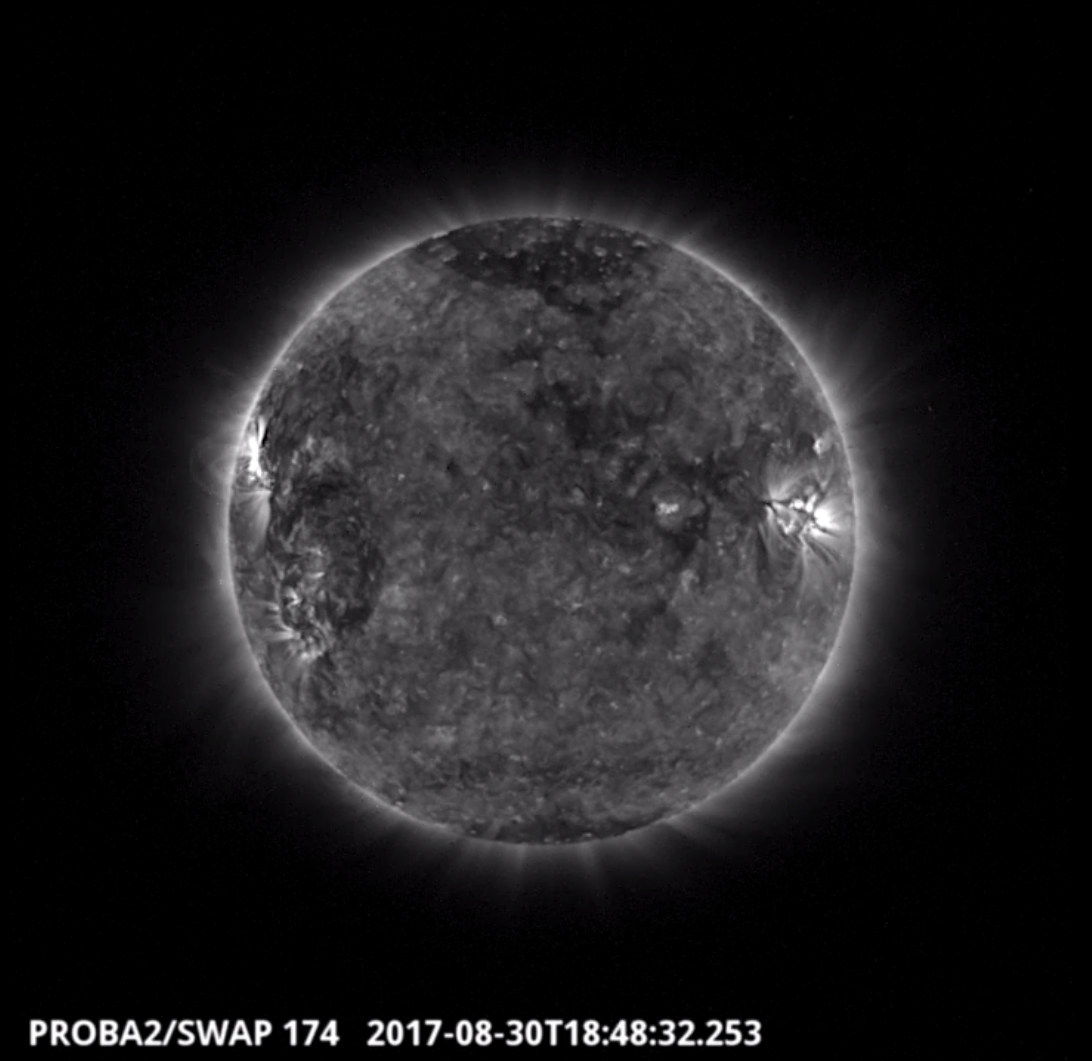
The second largest flare of the week (C5.2) was produced by NOAA active region 2674 on 2017-Aug-30 near to the eastern limb, as shown in the SWAP image above at 18:48 UT.
Find a movie of the events here (SWAP movie): http://proba2.oma.be/swap/movies/20170830_swap_movie.mp4
Saturday Sep 02
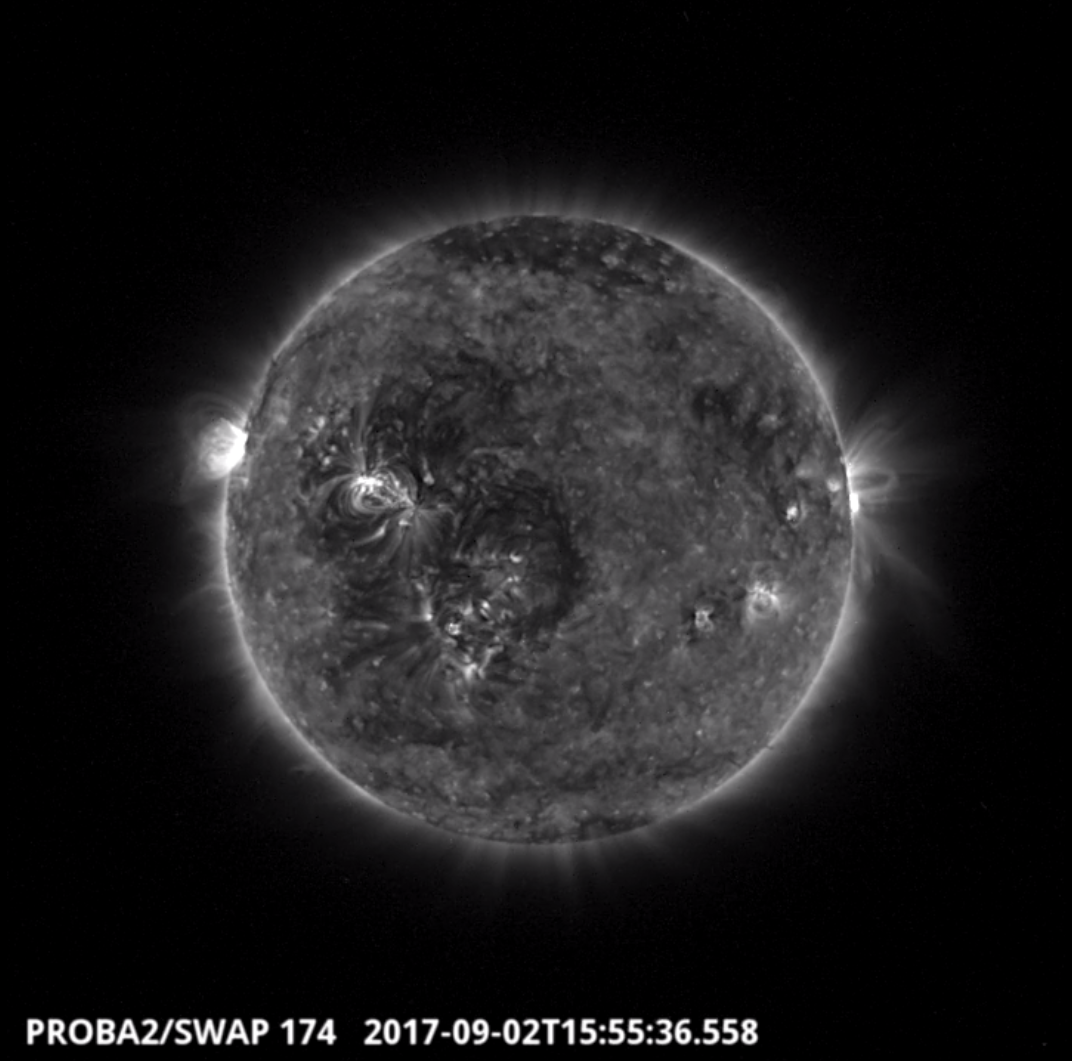
The largest flare of the week and an associated eruption from NOAA active region 2672 was observed by SWAP as it passed over the western limb of the Sun on 2017-Sep-02.
Find a movie of the events here (SWAP movie):
http://proba2.oma.be/swap/movies/20170902_swap_movie.mp4
Review of solar activity
During the past week, the solar activity was relatively low although a number of regions had the potential to induce some activity.
In the beginning of the week, Catania group 42 (NOAA region 2671) produced a C6.3-class flare before disappearing behind the West solar limb.
A faint and slow CME was observed on August 28 (first seen at 17:12 UT on LASCO-C2), originating from Catania group 43 (NOAA region 2672), which was located at 30 degrees west from central meridian at that moment. The CME was directed to the west. The CME had no impact on Earth.
The activity became enhanced when Catania group 47 (NOAA region 2674) rotated from behind the East solar limb with several C-class flares and narrow CMEs.
By the end of the week, Catania group 43 (NOAA region 2672) produced the largest flare of the week at 15:41 UT on September 2, which was a C7.7-class flare associated with a CME and a type II burst. While Catania group 47 (NOAA region 2674) was decaying over the week, the photospheric magnetic complexity from Catania group 46 (NOAA region 2673) increased but it did not show any flaring activity during the week.
Just below the promising evolution of Catania group 46. Check out the news 'The Sun throwing more parties' and 'Weather in space is picking up'
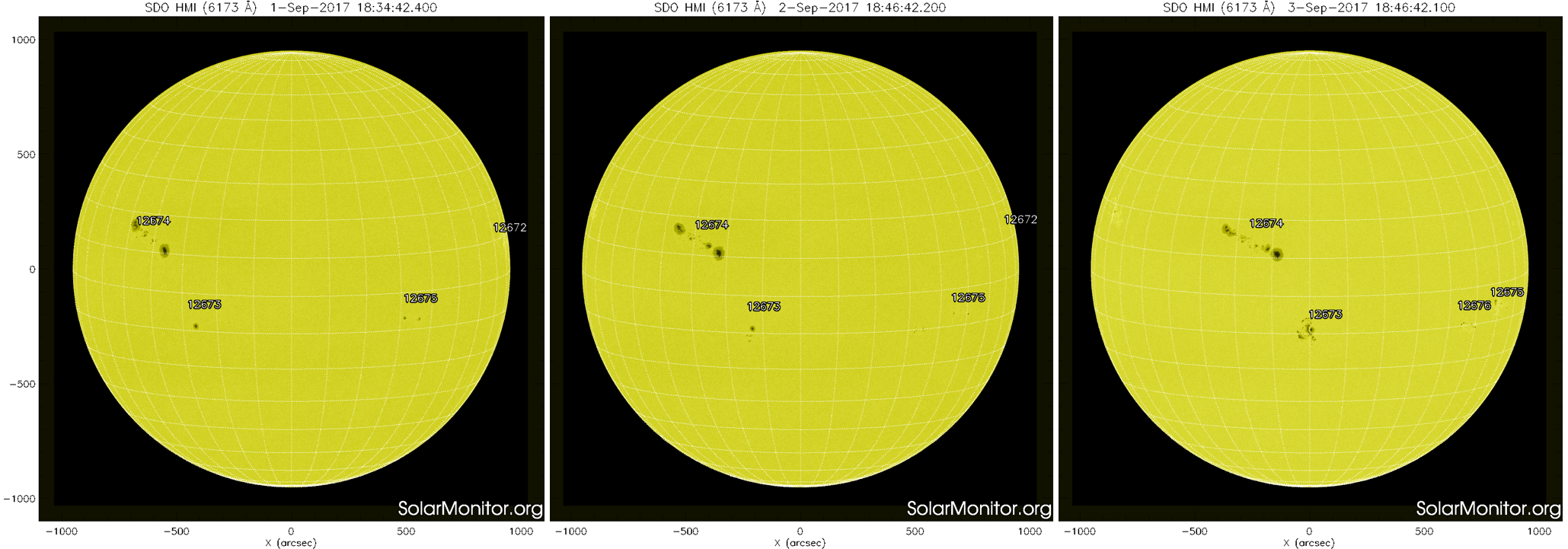
No Earth directed Coronal Mass Ejections (CMEs) have been detected in available coronagraph imagery and the solar protons remained at background level over the past week.
The International Sunspot Number
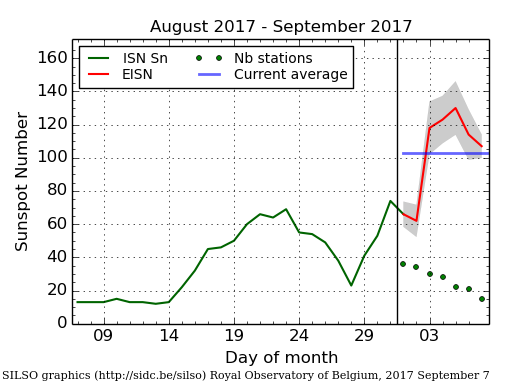
The daily Estimated International Sunspot Number (EISN, red curve with shaded error) derived by a simplified method from real-time data from the worldwide SILSO network. It extends the official Sunspot Number from the full processing of the preceding month (green line). The plot shows the last 30 days (about one solar rotation). The horizontal blue line shows the current monthly average, while the green dots give the number of stations included in the calculation of the EISN for each day.
Review of geomagnetic activity
In the beginning of the week, the Earth was inside the slow solar wind and the geomagnetic conditions were very quiet with Kp (NOAA) and local K (Dourbes) indexes ranging between 1 and 3.
The geomagnetic conditions became active on August 29 (Kp and K-Dourbes = 4) due to a sector boundary crossing. This announced the soon arrival of a high speed streamer coming. from a coronal hole extending from the North pole to about 20 latitude South. The coronal hole reached the central meridian on August 28.
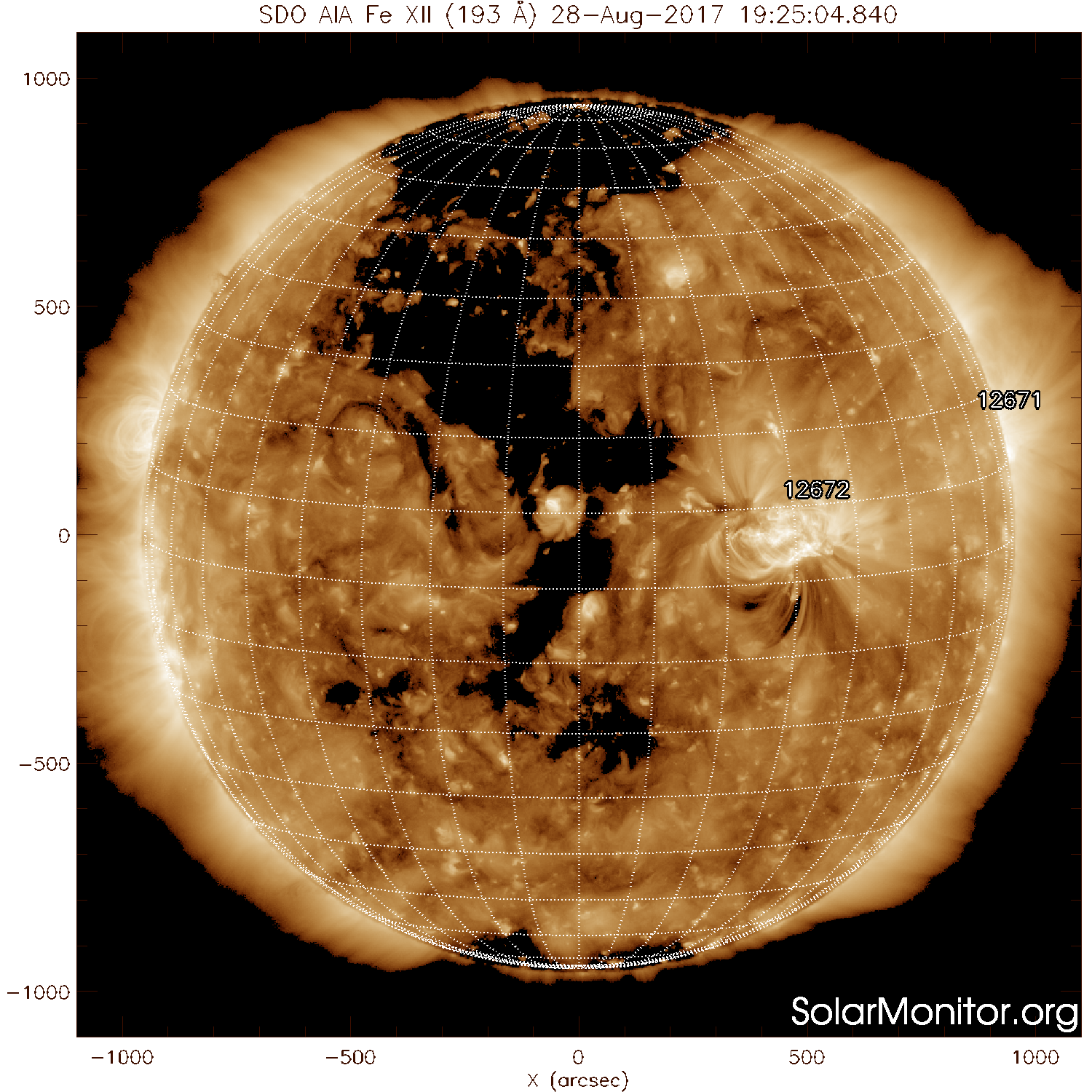
The high speed stream arrived at Earth on August 31. The solar wind speed increased up to 700 km/s and the geomagnetic conditions were active with a moderated storm (K-Dourbes=6, Kp-NOAA = 5) on August 31 around 10:00 UT. The geomagnetic conditions were then fluctuating between unsettled to active conditions until the high speed stream faded.
At the end of the week, on August 3, the solar wind decreased to 500 Km/s and the geomagnetic conditions gradually returned to nominal level.
The SIDC Space Weather Briefing
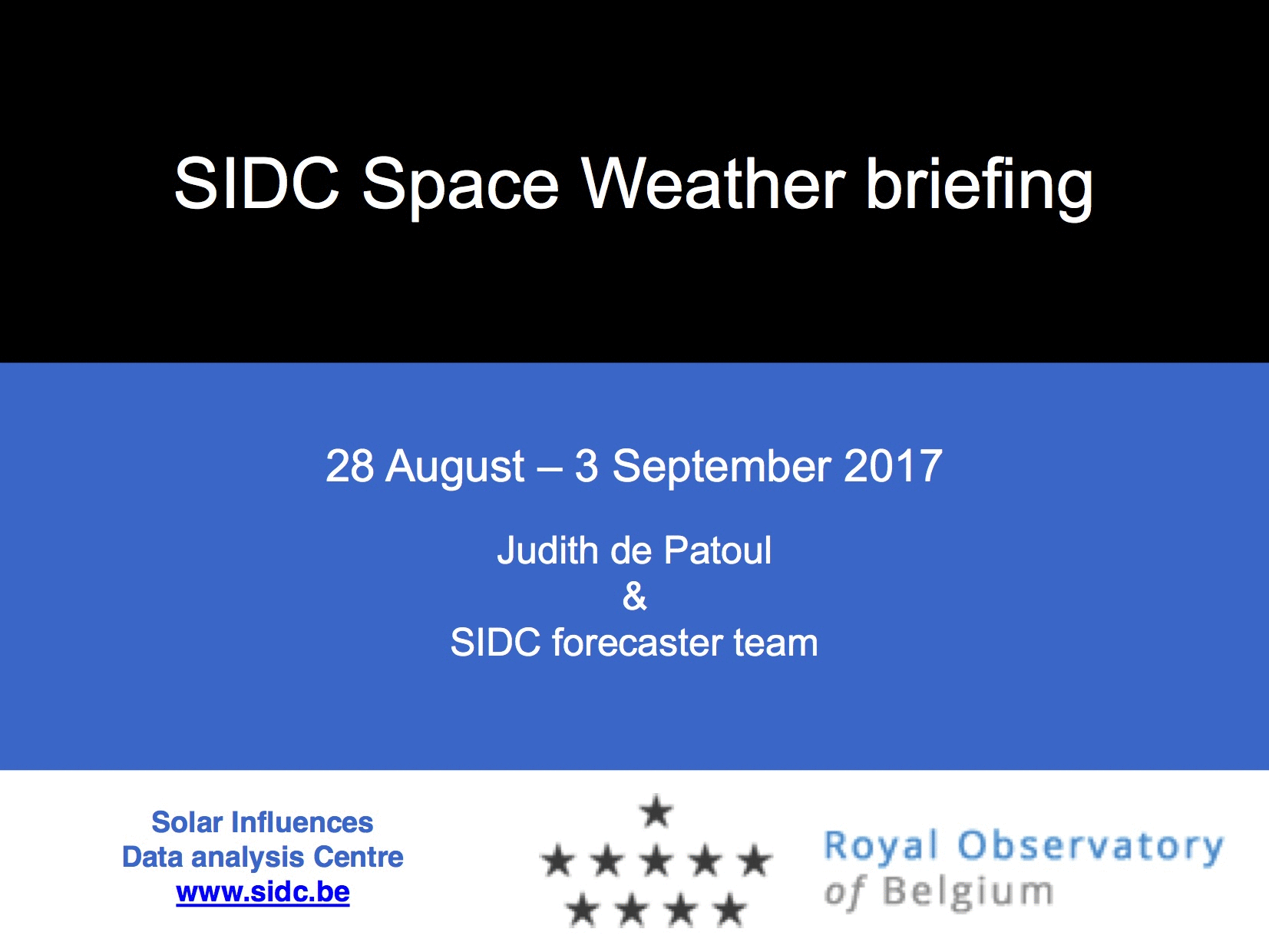
The Space Weather Briefing presented by the forecaster on duty from Aug 28 to Sep 3. It reflects in images and graphs what is written in the Solar and Geomagnetic Activity report.
Review of ionospheric activity (28 Aug 2017 - 3 Sep 2017)
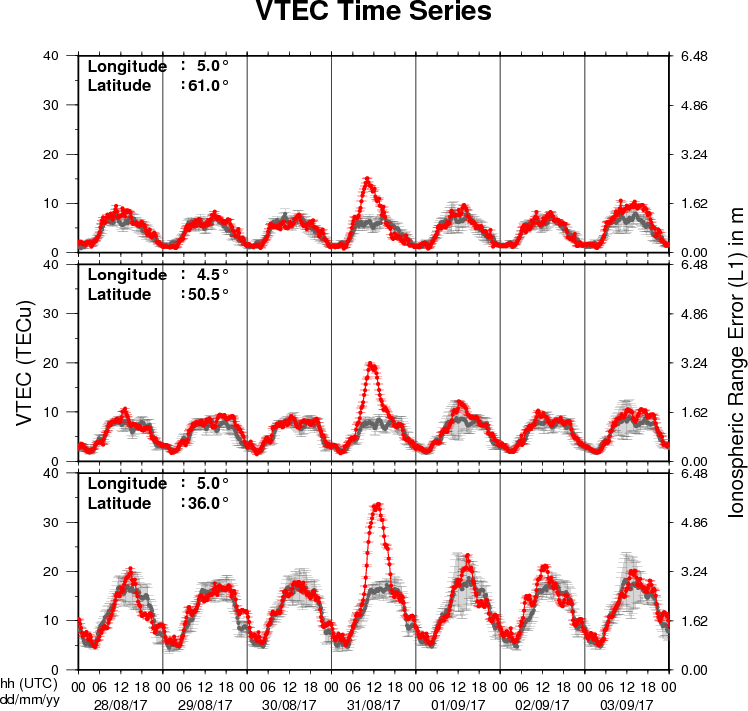
The figure shows the time evolution of the Vertical Total Electron Content (VTEC) (in red) during the last week at three locations:
a) in the northern part of Europe(N61°, 5°E)
b) above Brussels(N50.5°, 4.5°E)
c) in the southern part of Europe(N36°, 5°E)
This figure also shows (in grey) the normal ionospheric behaviour expected based on the median VTEC from the 15 previous days.
The VTEC is expressed in TECu (with TECu=10^16 electrons per square meter) and is directly related to the signal propagation delay due to the ionosphere (in figure: delay on GPS L1 frequency).
The Sun's radiation ionizes the Earth's upper atmosphere, the ionosphere, located from about 60km to 1000km above the Earth's surface.The ionization process in the ionosphere produces ions and free electrons. These electrons perturb the propagation of the GNSS (Global Navigation Satellite System) signals by inducing a so-called ionospheric delay.
See http://stce.be/newsletter/GNSS_final.pdf for some more explanations ; for detailed information, see http://gnss.be/ionosphere_tutorial.php
Future Events
For more details, see http://www.spaceweather.eu/en/event/future
International Workshop on Solar, Heliospheric & Magnetospheric Radioastronomy in Meudon, France
Start : 2017-11-06 - End : 2017-11-10
Jean-Louis Steinbeg has been one of the major pioneers in
radioastronomy. Co-founder of the Nançay Observatory, he
has actively participated to, an inspired a large number of radio
instruments on many international space missions. Jean-Louis
Steinberg is the founder of the Space Radioastronomy laboratory of
the Paris Observatory in 1963. Later on, this laboratory widened
its science interests and became the DESPA (1971) and then the
current LESIA (2002) which is one of the major space sciences
laboratories in France. The aim of this workshop is to cover the
science topics which Jean-Louis Steinberg has promoted during his
career, focusing on Solar, Heliospheric & Magnetospheric
radioastronomy & physics. This will be done by covering both
observations from either ground facilities (NDA, RH, LOFAR, Artemis
etc ...) or space missions (ISSEE, Ulysses, WIND, CLUSTER, STEREO,
CASSINI, JUNO etc ...) and models/theories. A series of invited
talks is also foreseen to cover the new developments in the
discipline which may come with the future facilities such as Solar
Orbiter, Solar Probe Plus, JUICE, JUNO, LOFAR+, SKA etc ....
This workshop will also be the opportunity to remember both the
extraordinary personal & professional lifes of Jean-Louis
Steinberg especially for new generation of scientists. At the
occasion of this workshop it is also expected that the Building 16
(historical Space Sciences building) on the Meudon campus will be
renamed "Building Jean-Louis Steinberg".
Website:
https://jlsworkshop.sciencesconf.org/
European Space Weather Week 14
Start : 2017-11-27 - End : 2017-12-01
The ESWW is the main annual event in the European Space Weather
calendar. It is the European forum for Space Weather as proven by
the high attendance to the past editions. The agenda will be
composed of plenary/parallel sessions, working meetings and
dedicated events for service end-users. The ESWW will again adopt
the central aim of bringing together the diverse groups in Europe
working on different aspects of Space Weather.
Website:
http://www.stce.be/esww14/
